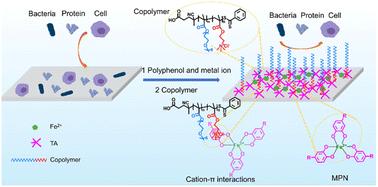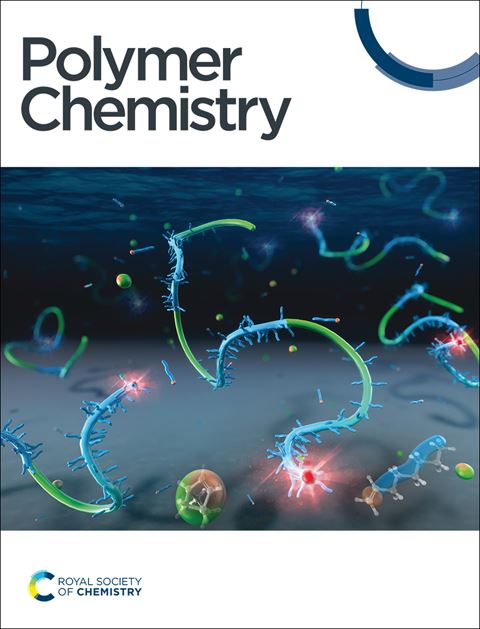Rapid formation of antifouling coatings via cation–π interactions†
IF 4.1
2区 化学
Q2 POLYMER SCIENCE
引用次数: 0
Abstract
To decrease the adhesion of proteins, bacteria, and cells and increase the usage duration of implants, minimizing biofouling is crucial in medical industries. Traditionally, antifouling coatings are covalently bonded to substrates, a process that can be time-consuming or substrate-dependent. In this study, we synthesized both block and random copolymers using poly(ethylene glycol) methyl ether methacrylate (PEGMA) and methacryloxyethyltrimethyl ammonium chloride (METAC) through reversible addition–fragmentation chain transfer (RAFT) polymerization. These copolymers can be adsorbed onto metal-phenolic network (MPN)-modified substrates based on cation–π interactions, rapidly forming antifouling coatings in about 6 min. Due to the wide surface modification ability of MPNs, the antifouling coatings could form on various substrates. The antifouling coatings can effectively resist the adhesion of proteins, cells, and bacteria. Moreover, block copolymers exhibited superior antifouling abilities compared to random copolymers. Notably, the antifouling performance of copolymers can be promoted by increasing the amount of PEGMA and METAC. The advantage of the reported method is the rapid preparation of antifouling coatings on various substrates. In addition, the study provides an insight into the factors influencing the strength of cation–π interactions.

通过阳离子-π相互作用快速形成防污涂层
为了减少蛋白质、细菌和细胞的粘附性并延长植入物的使用时间,最大限度地减少生物污染在医疗行业中至关重要。传统上,防污涂层是通过共价键连接到基底上的,这一过程可能很耗时,也可能与基底有关。在本研究中,我们利用聚乙二醇甲基醚甲基丙烯酸酯(PEGMA)和甲基丙烯酰氧乙基三甲基氯化铵(METAC)通过可逆加成-断裂链转移(RAFT)聚合反应合成了嵌段和无规共聚物。这些共聚物可吸附在基于阳离子-π相互作用的金属-酚醛网络(MPN)改性基底上,在约 6 分钟内迅速形成防污涂层。由于 MPN 具有广泛的表面改性能力,因此可在各种基底上形成防污涂层。防污涂层能有效抵抗蛋白质、细胞和细菌的附着。此外,与无规共聚物相比,嵌段共聚物的防污能力更强。值得注意的是,通过增加 PEGMA 和 METAC 的用量可以提高共聚物的防污性能。所报告方法的优点是可以在各种基底上快速制备防污涂层。此外,该研究还有助于深入了解影响阳离子-π相互作用强度的因素。
本文章由计算机程序翻译,如有差异,请以英文原文为准。
求助全文
约1分钟内获得全文
求助全文
来源期刊

Polymer Chemistry
POLYMER SCIENCE-
CiteScore
8.60
自引率
8.70%
发文量
535
审稿时长
1.7 months
期刊介绍:
Polymer Chemistry welcomes submissions in all areas of polymer science that have a strong focus on macromolecular chemistry. Manuscripts may cover a broad range of fields, yet no direct application focus is required.
 求助内容:
求助内容: 应助结果提醒方式:
应助结果提醒方式:


